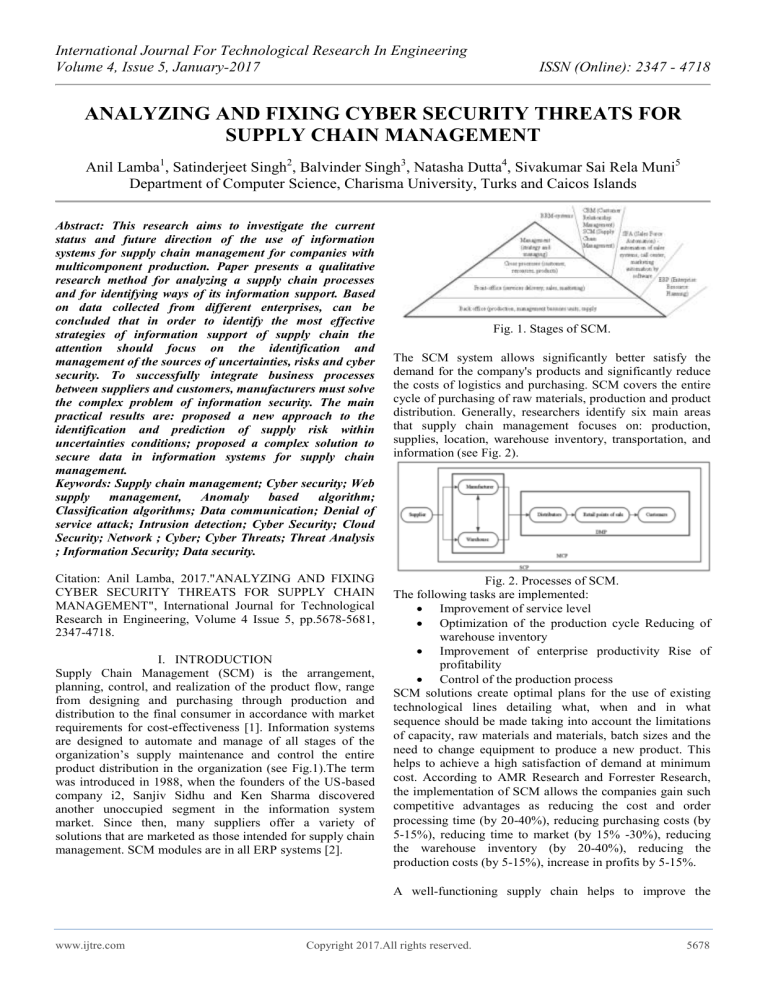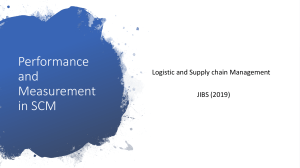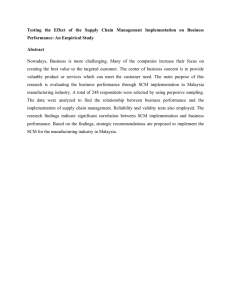
International Journal For Technological Research In Engineering
Volume 4, Issue 5, January-2017
ISSN (Online): 2347 - 4718
ANALYZING AND FIXING CYBER SECURITY THREATS FOR
SUPPLY CHAIN MANAGEMENT
Anil Lamba1, Satinderjeet Singh2, Balvinder Singh3, Natasha Dutta4, Sivakumar Sai Rela Muni5
Department of Computer Science, Charisma University, Turks and Caicos Islands
Abstract: This research aims to investigate the current
status and future direction of the use of information
systems for supply chain management for companies with
multicomponent production. Paper presents a qualitative
research method for analyzing a supply chain processes
and for identifying ways of its information support. Based
on data collected from different enterprises, can be
concluded that in order to identify the most effective
strategies of information support of supply chain the
attention should focus on the identification and
management of the sources of uncertainties, risks and cyber
security. To successfully integrate business processes
between suppliers and customers, manufacturers must solve
the complex problem of information security. The main
practical results are: proposed a new approach to the
identification and prediction of supply risk within
uncertainties conditions; proposed a complex solution to
secure data in information systems for supply chain
management.
Keywords: Supply chain management; Cyber security; Web
supply
management,
Anomaly
based
algorithm;
Classification algorithms; Data communication; Denial of
service attack; Intrusion detection; Cyber Security; Cloud
Security; Network ; Cyber; Cyber Threats; Threat Analysis
; Information Security; Data security.
Citation: Anil Lamba, 2017."ANALYZING AND FIXING
CYBER SECURITY THREATS FOR SUPPLY CHAIN
MANAGEMENT", International Journal for Technological
Research in Engineering, Volume 4 Issue 5, pp.5678-5681,
2347-4718.
I. INTRODUCTION
Supply Chain Management (SCM) is the arrangement,
planning, control, and realization of the product flow, range
from designing and purchasing through production and
distribution to the final consumer in accordance with market
requirements for cost-effectiveness [1]. Information systems
are designed to automate and manage of all stages of the
organization’s supply maintenance and control the entire
product distribution in the organization (see Fig.1).The term
was introduced in 1988, when the founders of the US-based
company i2, Sanjiv Sidhu and Ken Sharma discovered
another unoccupied segment in the information system
market. Since then, many suppliers offer a variety of
solutions that are marketed as those intended for supply chain
management. SCM modules are in all ERP systems [2].
Fig. 1. Stages of SCM.
The SCM system allows significantly better satisfy the
demand for the company's products and significantly reduce
the costs of logistics and purchasing. SCM covers the entire
cycle of purchasing of raw materials, production and product
distribution. Generally, researchers identify six main areas
that supply chain management focuses on: production,
supplies, location, warehouse inventory, transportation, and
information (see Fig. 2).
Fig. 2. Processes of SCM.
The following tasks are implemented:
Improvement of service level
Optimization of the production cycle Reducing of
warehouse inventory
Improvement of enterprise productivity Rise of
profitability
Control of the production process
SCM solutions create optimal plans for the use of existing
technological lines detailing what, when and in what
sequence should be made taking into account the limitations
of capacity, raw materials and materials, batch sizes and the
need to change equipment to produce a new product. This
helps to achieve a high satisfaction of demand at minimum
cost. According to AMR Research and Forrester Research,
the implementation of SCM allows the companies gain such
competitive advantages as reducing the cost and order
processing time (by 20-40%), reducing purchasing costs (by
5-15%), reducing time to market (by 15% -30%), reducing
the warehouse inventory (by 20-40%), reducing the
production costs (by 5-15%), increase in profits by 5-15%.
A well-functioning supply chain helps to improve the
www.ijtre.com
Copyright 2017.All rights reserved.
5678
International Journal For Technological Research In Engineering
Volume 4, Issue 5, January-2017
planning system, optimize warehouse inventory, make timely
deliveries, ensure offer to demand conformity, reduce costs
and, as a result, increase the company's market value.
The current trends in the development of SCM technologies
are defined by the enormous possibilities of the Internet. The
chains of manufacturers, suppliers, contractors, transport and
trading companies are intertwined in the most intimate way
and are already real online networks. Companies merge into
the business community, and the boundaries between them
are disappeared. However, there is a transparency of joint
activities, performers can quickly adapt to customer
requirements, as well as quickly bring new products to the
market using advanced methods of prediction and planning.
The Internet is the simplest, cheapest, and most efficient
technological means to manage and control the partner
networks. Companies usually start with combination of the
simplest activities using emails and workflow automation
systems, then moving on to virtual docking of the most
important business processes, and then merging into one
virtual corporation within which the entire network is
synchronized. This is already a transition to global ecommerce, when all business transactions and payments are
arranged through the Web without exception.
As a result, not only productivity significantly increases, but
also all processes significantly accelerate which lead to
qualitatively new effects. For example, such a network
system can minimize the impact of almost any negative
external influences and create new products much faster than
competitors. One of the first corporations that successfully
switched to the parallel design of their products (laser
printers) by uniting development teams from different
countries is Hewlett-Packard. A company like Adaptec saves
$ 10 million annually using web-based design with partners
from Japan.
Approximately as much save Boeing and TRW when
conducting joint research. And General Motors, working
through the CommerceOne TradeXchange e-platform and
selecting suppliers in fact in real time, saves about $ 400
million annually on costs. [3]
However, in spite of the obvious advantages of Web Supply
Management, there is a huge amount of uncertainty and
cyber security risks. All these types of vulnerabilities and
other weaknesses can leave users vulnerable to the threat
being compromised or attacked. Inefficient security methods
include, such as not sufficiently fast fixing of known
vulnerabilities, unlimited privileged access to cloud systems,
and unmanaged terminators and infrastructure.
We also consider the question: why the expansion of the
Internet creates an even greater risk for organizations and
their users, as well as for consumers, and what information
www.ijtre.com
ISSN (Online): 2347 - 4718
security specialists must do now to eliminate these risks
before it becomes impossible to control them.
II. TYPES OF VULNERABILITIES: WAYS TO
CONDUCT WEB-ATTACKS
The use of proxy servers is often an integral part of the
implementation and operation of Supply Chain
Management. Proxy servers have existed since the Internet
inception, and their functionality has developed directly with
it. Today, information security specialists use proxy servers
when scanning content to identify a potential threat that are
search for vulnerable Internet infrastructures or network
weaknesses that allow hackers to gain unauthorized access
to Supply Chain Management, penetrate into them and
conduct their campaigns. Among these threats are [4]:
Potentially unwanted applications (PUA), such as
malicious browser extensions Trojans (droppers and
loaders)
Links to web spam and fraudulent advertising
Browser vulnerabilities, such as JavaScript and
graphics rendering engines
Browser redirection, clickjacking and other methods
used to direct users to fraudulent web content
Table 1 shows the most common types of malicious software
that hackers used from November 2016 to May 2017. The
list given in Table 1 contains a number of the most reliable
and cost-effective methods for compromising a large number
of users of Supply Chain Management [5].
Table 1. The most common malware, November 2017 - May
2018.
They include the following:
"Primary loads", such as Trojans and utilities that
facilitate the initial infection of a user's computer (a
macro virus in a malicious Word document is an
example of this type of tool)
PUA, which include malicious browser extensions
Suspicious Windows binaries that spread threats
such as adware and spyware Facebook fraud which
includes fake offers, media content and deception
Malware includes ransomware programs and agents
to steal data when typing from the keyboard that
deliver the load on compromised nodes
2.1. Spyware
Most of modern online advertising software in the Internet is
potentially unwanted application (PUA) and is spyware.
Spyware providers advertise their software as legal tools that
provide useful services and adhere to end-user license
agreements. Spyware disguised as PUA is software that
secretly collects information about a user's computer activity.
It is usually installed on a computer without the user's
knowledge. In this study, spyware is divided into three broad
Copyright 2017.All rights reserved.
5679
International Journal For Technological Research In Engineering
Volume 4, Issue 5, January-2017
ISSN (Online): 2347 - 4718
categories: adware, system monitors and Trojans. In a
corporate environment, spyware represents a number of
potential security risks. For example, it may do the following:
Steal user and company information, including
personal data and other proprietary or confidential
information
Reduce the effectiveness of security devices by
changing their configurations and settings, installing
additional software and providing access to third
parties. Spyware can also potentially remotely
execute arbitrary code on devices, allowing hackers
to completely control the device
Increase the number of infections. Once users are
infected with PUA, such as by spyware or adware,
they are vulnerable to even more malware infections
2.2. Spyware business email compromise
Recently, in the field of security, much attention has been
paid to extortion programs. Nevertheless, another threat, by
no means of such a high level, which gives its creators much
more than ransomware, is the compromise of corporate email. Today, this is currently the most profitable way to get a
lot of money from a business. This is a deceptively light
attack vector that uses social engineering to initiate theft. In
the simplest version, the campaign to compromise business
email includes the delivery of email to employees of financial
departments (sometimes using fake data from other
employees), who can send funds via bank transfer.
accounting information). As in the case of CouchDB, over
75% of Elasticsearch servers can be classified as maximally
open. Unlike CouchDB, only an extremely small part of
these servers may contain personal data. Docker is a software
platform, whose operators from the very beginning paid
great attention to security. However, despite these efforts,
over 1,000 Docker instances are maximally open. Most
Docker instances were found in the USA or China.
3.2. Cloud technologies
The cloud is a new area for hackers who are actively
exploring it in order to gain new potential for their attacks.
Hackers realize that cloud systems are vital for many Web
Supply Management. They also realize that they can break
into corporate systems faster if they can break into a cloud
system.
Hackers usually carry out some researches in hierarchy of the
companies and its employees, for example, using profiles in
social networks, and build management vertical. This may be
a letter from the CEO or another top manager asking him to
transfer a non-cash payment to a prospective business partner
or supplier. The messageshould motivate the recipient to send
money, which as a result will usually end up in foreign or
regional bank accounts owned by cybercriminals.
It is a problem that affects organizations working in the
public, healthcare, and financial and technology sectors.
Unmanaged network infrastructure and end devices can be
easily attacked by hackers who need a base to integrate into
the organization’s infrastructure and compromise specific
objects. They can also be used to extract data or send
unauthorized Tor traffic, or they can be part of a botnet.
Even a simple router, firewall, or incorrect segmentation
setting can allow a hacker to break into the infrastructure and
gain access to confidential data.
Since messages aimed to compromise the business email do
not contain malicious or suspicious links, they can usually
avoid almost all the most sophisticated threat defenses.
III. TYPES OF VULNERABILITIES: WAYS TO
CONDUCT SERVICE-ATTACKS
3.1. DevOps services
Despite the fact that SCM in their own way are proprietary
IC, they are based on free or shareware DevOps services. By
this concept is meant such technologies as Docker, MySQL,
MariaDB and other popular DevOps components [6].
In January 2017, hackers began to encrypt publicly- available
instances of MongoDB and demand a ransom for decryption.
Later, hackers began to encrypt other types of databases, such
as CouchDB and Elasticsearch. Services like DevOps
services are often vulnerable because they are improperly
deployed or intentionally left open to facilitate access by
legitimate users. About 75% of CouchDB servers can be
classified as maximally open (accessible via the Internet and
do not require authentication). Only less than one quarter of
them require authentication (at least entering some
www.ijtre.com
Modern dynamic networks provide more opportunities for
attack creating new security risks and reducing the
possibility of control. The main source of such risks is the
cloud. In addition, unauthorized and so -called shadow IT
devices and applications create problems. End-companies
underestimate the risk (and number) of loopholes in their
corporate network, cloud and end-device infrastructure. The
lack of simple control leads to the fact that, on the average,
from 20 to 40% of the network infrastructure and
infrastructure of end-devices becomes inaccessible for
analysis or management of an organization [7].
3.3. IoT
The Internet of Things (Internet of Things, IoT) is the
interconnection of physical devices, vehicles, buildings and
other items (often called “connected devices” or “smart
devices”) that have built-in electronics, software, sensors,
actuators and are capable to connect to the network, allowing
them to collect data and share it. IoT includes three main
elements: information technology (IT), operational
technology (OT) and consumer technology (CT).
Industrial Internet of Things (Industrial Internet of Things,
IIoT) means only connected devices within a production
control network as opposed to a corporate IT network or
datacenter. IoT offers great possibilities for cooperation and
innovation in the business field. However, as it grows, there
is the increasing of security risk of organizations and users.
One of the problems is the complexity of monitoring. Most
information security specialists do not know which
IoT devices are connected to their network. Security, as a
rule, doesn’t have top priority when creating IoT devices
Copyright 2017.All rights reserved.
5680
International Journal For Technological Research In Engineering
Volume 4, Issue 5, January-2017
(and these are all devices, starting with cameras and ending
with thermostats and intelligent measuring instruments).
Many of these devices are far behind in terms of security
from desktop systems and have vulnerabilities fixing of
which can take months or even years. In addition, they are
characterized by [8]:
Vulnerability and risk reporting and updates are
almost or completely missing The launch is made on
a specialized architecture
The presence of non-updated or deprecated
applications that have vulnerabilities, for example,
Windows XP Fixing is rarely used
The difficulty in the security issue of IoT devices is added by
the fact that information security specialists may not
comprehend the nature of the alarms coming from these
devices. In addition, it is not always clear who among the
employees in the company is responsible in case of attacks
on IoT. The teams responsible for implementing of these
technologies, as a rule, leave the organization after the
project is implemented.
IV. CONCLUSION
Organizations need real-time security context analysis to
ensure easy control. In the absence of solutions that provide
real-time monitoring and leak path detection, attackers can
move around in the network without being noticed. In
addition, organizations must test their segmentation policies
and implement robust tools to verify the effectiveness of such
policies. Organizations must also take the inventory devices
and systems that are connected to the network. If security
teams can only check with snapshots or old lists of managed
devices, they can skip at least 20% of devices physically
connected to the network via a wired connection. Such
inventories should be regular and automatic, as the corporate
network, cloud infrastructure and end-device infrastructure
are constantly changing and cannot be effectively monitored
by staff manually.
[2]
[3]
[4]
[5]
[6]
[7]
[8]
ISSN (Online): 2347 - 4718
and further research directions.” Journal of Cleaner
Production, 142: 1119–1130.
Ovacik, I. M. (2011). Advanced planning and
scheduling systems: the quest to leverage ERP for
better planning. In Planning Production and
Inventories in the Extended Enterprise(pp. 33-43).
Springer, Boston, MA.
Baskerville, R., F. Rowe, and F. C. Wolff. (2018)
“Integration
of
information
systems
and
cybersecurity countermeasures: An exposure to risk
perspective.” ACM SIGMIS Database: the
DATABASE for Advances in Information
Systems49 (1): 33–52.
Polatidis, N., M. Pavlidis, and H. Mouratidis.
(2018) “Cyber-attack path discovery in a dynamic
supply chain maritime risk management system.”
Computer Standards & Interfaces56: 74-82.
Cisco 2018 Annual Cybersecurity Report.
(2018).Available:https://www.cisco.com/c/dam/m/h
u_hu/campaigns/security-hub/pdf/acr-2018.pdf.
[Accessed: October 18, 2018].
Boiko, A., V. Shendryk. (2017) ”System Integration
and Security of Information Systems.” Procedia
Computer Science104: 35–42.
Gaudenzi, B., and G. Siciliano. (2017). “Managing
IT and Cyber Risks in Supply Chains.” Supply
Chain Risk Management, 85-96. doi: 10.1007/978981-10-4106-8_5
Khojasteh-Ghamari, Z., and T. Irohara. (2017).
Supply Chain Risk Management: A Comprehensive
Review. Supply Chain Risk Management,3-22. doi:
10.1007/978-981-10-4106-8_1.
The situation is further complicated by the fact that Supply
Chain Management is on the boundary of the transport and
IT industries. The technological infrastructure of the
transport industry has traditionally been based on closed,
proprietary systems. Today, the industry is moving to modern
network connections. It is necessary to move to connected IP
systems because existing systems require expensive
maintenance and are complex. In addition, consumers are
waiting for new secure and mobile services that the existing
communication infrastructure cannot offer.
For example, consumers want to be able to interact with
airports, airlines, passenger and cargo rail traffic, highways
or connected fleets and public transport departments on
social networks using mobile devices or use mobile
applications in vehicles.
REFERENCES
[1] Dubey, R., A. Gunasekaran, T. Papadopoulos, S. J.
Childe, K. T. Shibin, and S. F. Wamba. (2017)
“Sustainable supply chain management: framework
www.ijtre.com
Copyright 2017.All rights reserved.
5681



